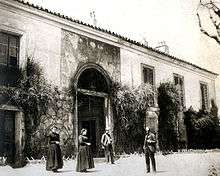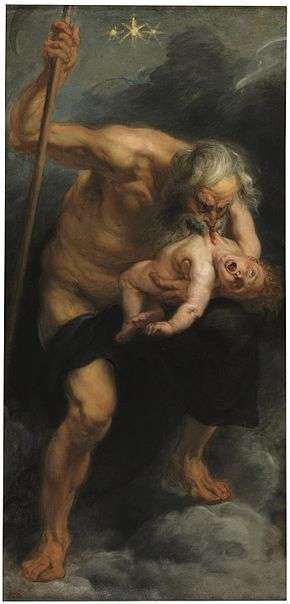Saturn Devouring His Son
Saturn Devouring His Son is the name given to a painting by Spanish artist Francisco Goya. According to the traditional interpretation, it depicts the Greek myth of the Titan Cronus (in the title Romanized to Saturn), who, fearing that he would be overthrown by one of his children,[1] ate each one upon their birth. The work is one of the 14 Black Paintings that Goya painted directly onto the walls of his house sometime between 1819 and 1823. It was transferred to canvas after Goya's death and has since been held in the Museo del Prado in Madrid.
| Saturn Devouring His Son | |
|---|---|
| Spanish: Saturno devorando a su hijo | |
.jpg) | |
| Artist | Francisco Goya |
| Year | c. 1819–1823 |
| Medium | Oil mural transferred to canvas |
| Dimensions | 143 cm × 81 cm (56 in × 32 in) |
| Location | Museo del Prado, Madrid |
Background

In 1819, Goya purchased a house on the banks of Manzanares near Madrid called Quinta del Sordo (Villa of the Deaf Man). It was a two-story house which was named after a previous occupant who had been deaf, although the name was fitting for Goya too, who had been left deaf after contracting a fever in 1792. Between 1819 and 1823, when he left the house to move to Bordeaux, Goya produced a series of 14 works, which he painted with oils directly onto the walls of the house. At the age of 73, and having survived two life-threatening illnesses, Goya was likely to have been concerned with his own mortality, and was increasingly embittered by the civil strife occurring in Spain. Although he initially decorated the rooms of the house with more inspiring images, in time he overpainted them all with the intensely haunting pictures known today as the Black Paintings. Uncommissioned and never meant for public display, these pictures reflect his darkening mood with some tense scenes of malevolence and conflict.[2]
Saturn Devouring His Son, a portrait of the titan Saturn consuming one of his children, was one of six works with which Goya decorated the dining room. According to Roman myth (inspired by the original Greek myth), it had been foretold that one of the sons of Saturn would overthrow him, just as he had overthrown his father, Caelus. To prevent this, Saturn ate his children moments after each was born. His wife Ops eventually hid his third son, Jupiter, on the island of Crete, deceiving Saturn by offering a stone wrapped in swaddling in his place. Jupiter eventually supplanted his father just as the prophecy had predicted.
Goya never named the works he produced at Quinta del Sordo; the names were assigned by others after his death,[3] and this painting is also known as just Saturn, Saturn Devouring One of His Sons, Saturn Devouring his Children or by the Spanish names Saturno devorando a su hijo or Saturno devorando a un hijo.
Painting
Goya depicts Saturn feasting upon one of his sons. His child's head and part of the left arm have already been consumed. The right arm has probably been eaten too, though it could be folded in front of the body and held in place by Saturn's thumbs. The titan is on the point of taking another bite from the left arm; as he looms from the darkness, his mouth gapes and his eyes bulge widely. The only other brightness in the picture comes from the white flesh, the red blood of the corpse, and the white knuckles of Saturn as he digs his fingers into the back of the body. There is evidence that the picture may have originally portrayed the titan with a partially erect penis,[5] but, if ever present, this addition was lost due to the deterioration of the mural over time or during the transfer to canvas; in the picture today the area around his groin is indistinct. It may even have been overpainted deliberately before the picture was put on public display.[6]

Various interpretations of the meaning of the picture have been offered: the conflict between youth and old age, time as the devourer of all things, the wrath of God and an allegory of the situation in Spain, where the fatherland consumed its own children in wars and revolution. There have been explanations rooted in Goya's relationships with his own son, Xavier, the only of his six children to survive to adulthood, or with his live-in housekeeper and possible mistress, Leocadia Weiss; the sex of the body being consumed cannot be determined with certainty. If Goya made any notes on the picture, they have not survived; as he never intended the picture for public exhibition, he probably had little interest in explaining its significance. It has been said that the painting is "essential to our understanding of the human condition in modern times, just as Michelangelo's Sistine Chapel ceiling is essential to understanding the tenor of the 16th century".[7]
Goya may have been inspired by Peter Paul Rubens' 1636 picture of the same name. Rubens' painting, also held at the Museo del Prado, is a brighter, more conventional treatment of the myth: his Saturn exhibits less of the cannibalistic ferocity portrayed in Goya's rendition. However, some critics have suggested that Rubens' portrayal is the more horrific: the god is portrayed as a calculating remorseless killer, who – fearing for his own position of power – murders his innocent child. Goya's vision, on the other hand, shows a man driven mad by the act of killing his own son. Or it could be interpreted as a titan driven wild with fear at the idea of usurpation from one of his children. In addition, the body of the son in Goya's picture is that of an adult, not the helpless baby depicted by Rubens. Goya had produced a chalk drawing of the same subject in 1796-7 that was closer in tone to Rubens' work: it showed a Saturn similar in appearance to that of Rubens', daintily biting on the leg of one of his sons while he holds another like a leg of chicken, with none of the gore or madness of the later work. Goya scholar Fred Licht has raised doubts regarding the traditional title however, noting that the classical iconographical attributes associated with Saturn are absent from the painting, and the body of the smaller figure does not resemble that of an infant.[3] The rounded buttocks and wide hips of the headless corpse has also called into question the identification of this figure as a male.[8]
Transfer from the Quinta del Sordo
Although they were not meant to be seen by the public, the paintings remain important works in Goya's oeuvre. When Goya went into self-imposed exile in France in 1823, he passed Quinta del Sordo to his grandson, Mariano. After various changes of ownership, the house came into the possession of the Belgian Baron Emile d'Erlanger in 1874. After 70 years on the walls of Quinta del Sordo, the murals were deteriorating badly and, in order to preserve them, the new owner of the house had them transferred to canvas under the direction of Salvador Martínez Cubells, the chief art restorer at the Museo del Prado. After showing them at the Exposition Universelle of 1878 in Paris, d'Erlanger eventually donated them to the Spanish state. The effects of time on the murals, coupled with the inevitable damage caused by the delicate operation of mounting the crumbling plaster on canvas, meant that most of the murals required restoration work and some detail may have been lost, but in this respect Saturn Devouring His Son appears to have fared better than some of the other works.
Influence
In 2010, Saturn Devouring His Son became a popular Internet meme after photoshopped images of the painting surfaced online. The figures depicted in the artwork have also been labelled frequently, Saturn usually representing something the meme's creator finds to be destructive.[9]
Notes
- "These great Cronos swallowed as each came forth from the womb to his mother's knees with this intent, that no other of the proud sons of Heaven should hold the kingly office amongst the deathless gods. For he learned from Earth and starry Heaven that he was destined to be overcome by his own son, strong though he was, through the contriving of great Zeus." - Hesiod "Theogony". Sacred-Texts.com. 2013-08-25. Retrieved 2013-08-25.
- "But never before and never since, as far as we know, has a major, ambitious cycle of paintings been painted with the intention of keeping the pictures an entirely private affair." Licht, 159
- Licht, 168
- "Goya's Saturn Devouring One of His Sons". smARThistory at Khan Academy. Retrieved December 18, 2012.
- Morden and Pulimood in Farthing, 375
- Connell, 209
- Licht, 71
- Connell, 210
- "Saturn Devouring His Son". Know Your Meme. Retrieved 2020-02-22.
References
| Wikimedia Commons has media related to Saturno devorando a su hijo. |
- Connell, Evan (2004). Francisco Goya: A Life. Counterpoint. p. 256. ISBN 978-1-58243-307-3.
- Licht, Fred (1983). Goya: The Origins of the Modern Temper in Art. Icon. p. 288. ISBN 0-06-430123-0.
- Morden, Karen & Pulimood, Stephen (2006). Stephen Farthing (ed.). 1001 Paintings You Must See Before You Die. London: Quintet Publishing Ltd. ISBN 1-84403-563-8.
- "Saturn Devouring One of His Sons". Museo del Prado. Retrieved 27 February 2007.
- E. Weems. "The Black Paintings: Saturn". Retrieved 27 February 2007.
- Jay Scott Morgan. "The Mystery of Goya's Saturn". New England Review. Archived from the original on 13 December 2006. Retrieved 27 February 2007.
- "Goya's Black Paintings". theartworlf. Retrieved 27 February 2007.
- Milko A. García Torres. "Francisco José Goya". Pinacoteca Universal Multimedia (in Spanish). Madrid: F & G Editores. Retrieved 27 February 2007.
- Hesiod, translated by Hugh G. Evelyn-White. "Theogony". Retrieved 2013-08-25.